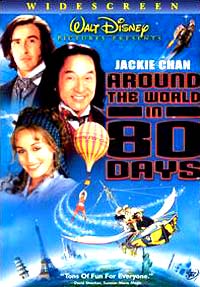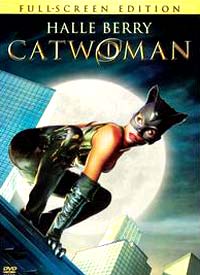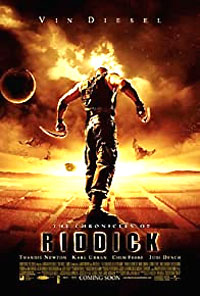
|
|
(chronologically, by film title) Intro | Summary Chart | Silents-1949 | 1950 -1966 | 1967-1969 | 1970-1974 | 1975-1977 | 1978-1979 1980 | 1981 | 1982 | 1983-1984 | 1985-1986 | 1987-1989 1990-1991 | 1992-1994 | 1995 - 1 | 1995 - 2 | 1996-1997 | 1998 | 1999 | 2000 | 2001 - 1 | 2001 - 2 2002 - 1 | 2002 - 2 | 2002 - 3 | 2003 | 2004 | 2005 | 2006 | 2007-2011 | 2012-2014 | 2015-2017 | 2018-2019 | 2020-2021 |
|
| Film Title, Director, Studio, Budget Information, Description | |

|
The Alamo (2004) Cowriter/director John Lee Hancock's over two-hour long western remake of the 1960 John Wayne film about the heroic 1836 battle at the Alamo (in San Antonio, Texas) between Mexican president Antonio López de Santa Anna's Mexican forces and a group of Texan immigrants, Tejanos (Texans of Mexican decent) and American volunteers, was a lengthy and bloated Disney (Touchstone) production. Its tagline: "You will never forget" was unintentionally a critique of its own boring, undramatic rendition. It was criticized as having a theadbare and sluggish script, stars that were poorly characterized or stereotyped, a loud score (by Carter Burwell), mostly bloodless violence, a lack of focus, and jerky editing, although it was much more historically accurate (and revisionistic) than its predecessor. After the 13-day siege and massacre of 183 rebels, it concluded with an 18-minute vengeful "happy ending" sequence of the decisive Battle of San Jacinto and the capture of Santa Anna by Sam Houston (apparently severely cut and recut over many months from about an hour to 20 minutes of film). It was notable for having "the biggest set ever" erected in North America - undoubtedly one of the reasons for its exorbitant cost. Budget overruns were astronomical for this costly flop. Following disastrous preview screenings for the historical drama, the solemn and mostly unexciting PG-13 film was trimmed down significantly from over three hours to 135 minutes, and its release date was postponed from December 2003 to April 2004 when it opened on Easter weekend against the immensely successful Mel Gibson film The Passion of the Christ (2004). Ron Howard was to direct the originally R-rated blockbuster film, and Russell Crowe (as Sam Houston) was slated to star, but they both pulled out (Howard demanded a budget of $200 million), although Howard remained as a producer. The delayed film faltered at a time when other Disney productions were also dismal failures, including the animated feature film Home on the Range (2004) (another $100 million production), Hidalgo (2004) and The Ladykillers (2004) with Tom Hanks. Billy Bob Thornton starred as heroic frontiersman and Tennessee congressman David (not Davy) Crockett - the most realized character in the film, with Emilio Echevarría as the cartoonish and degenerate despotic Mexican commander, Dennis Quaid as drunken Gen. Sam Houston, Jason Patric as tubercular knife designer Col. James Bowie, and Patrick Wilson as incompetent Lt. Col. William Travis. |

|
Alexander (2004) Writer/director Oliver Stone's three-hour historical adventure and biographical epic about legendary Macedonian king Alexander (the Great) (Colin Farrell) was an overblown and tedious film with two extensively-staged bloody battle scenes (the Battle of Gaugamela against the Persians and the elephant attack in the forests of India, both savagely edited). It was a miscalculating sword-and-sandal epic like the dull mid-50s film with Richard Burton titled Alexander the Great (1955). The film, with the tagline: "Fortune favors the bold" opened with Alexander's death (at the young age of 32), and then narrator Anthony Hopkins gravely intoned as Ptolemy, as he proceeded to endlessly relate the socio-political story of the title character's life, to keep the confusingly-disjointed filmed narrative straight. The all-star cast for this massive misfire included Angelina Jolie and Val Kilmer as Alexander's love-smothering, phallic snake-worshipping mother-sorceress and drunken, one-eyed abusive ex-warrior father, Queen Olympias and King Philip II, respectively, and Rosario Dawson as his Indian-Bactrian tribal wife Roxane. However, the bi-sexual king took as his lovers his trusted boyhood friend/soulmate Hephaistion (Jared Leto with heavy eyeliner mascara) and Persian slave boy-eunuch Bagoas (Francisco Bosch). However, there were strangely no explicit male sex scenes (including caressing or kissing, although there was lots of innuendo and soulful gazes), given the obsession about Alexander's alleged sexual preferences. At the center of the demythologizing picture was a flawed, not-larger-than-life, self-doubting hero. A miscast Colin Farrell (with an Irish accent) was only mediocre and unconvincing as an indecisive, unconventional and confused 4th century conqueror, wearing an atrocious looking blonde wig (and other warrior-garb while looking like a rock star) and making the "great" king mostly inconsequential as he vanquished the world. His incongruous wedding night experience with naked, knife-wielding "barbarian" Roxane was unintentionally hilarious, with the two of them wrestling, hissing and clawing at each other like wild cats while struggling for control and dominance, and then experiencing unbridled passionate heterosexual sex. The ambitious film about a flawed and complex historical figure (re-interpreted by Stone) had limited appeal, unlike the clear heroics and leadership of the title characters in Patton (1970), Lawrence of Arabia (1962), Braveheart (1995) and Gladiator (2000), with its excessive psychologizing of Alexander's character. It received a total of six Razzie nominations: Worst Actor (Colin Farrell), Worst Actress (Angelina Jolie), Worst Director, Worst Picture, Worst Screenplay, and Worst Supporting Actor (Val Kilmer). To appease continuing criticism of his much-derided film by both critics and cinemagoers, Oliver Stone released a third DVD-only version of his epic, a 3-hour and 40 minute feature with deleted scenes reinstated. In early 2005, Stone blamed "raging fundamentalism in morality" in America for the film's ultimate failure, claiming that the catchphrase "Alex is Gay" turned off potential audiences. |

|
Around the World in 80 Days (2004) Disney's silly, old-fashioned, but good-natured all-star family film remake of the Best Picture-winning 1956 film of the same name (starring David Niven), and very loosely based on Jules Verne's 1872 novel, was a huge commercial disaster, even though it aspired to be an appealing and crowd-pleasing movie. The mostly-goofy film starred martial arts expert and comic slapstick stunt man Jackie Chan as posing valet Passepartout (aka Lau Xing) and British comic Steve Coogan as the stuffy eccentric inventor and Victorian English gentleman Phileas Fogg of the Royal Academy of Science who was to circumnavigate the globe -- with an accompanying female character, frustrated Parisian impressionistic painter Monique La Roche (French/Belgian actress Cécile de France). Their wagered journey around the world was pumped up with the inclusion of a jade Buddha statue (stolen from Passepartout's Chinese homeland) robbed from the Bank of England to be returned to China and a long-nailed menacing female Chinese warlord of the Black Scorpions named General Fang (Hong Kong actress Karen Joy Morris), and lots of cameos (Arnold Schwarzenegger appeared as lecherous Turkish sultan Prince Hapi in a ridiculous curly black wig with a hottub scene, Jim Broadbent as wagering snobbish Minister of Science Lord Kelvin, Kathy Bates as Queen Victoria, Rob Schneider as a San Francisco bum, billionaire Richard Branson as ironically, the Balloon Man, Luke and brother Owen Wilson as early traveling bicycle salesmen Orville and Wilbur Wright, etc.). The fast-moving but palid and belabored travelogue, mixed together with the standard elements of a Jackie Chan film, followed the group as they traveled eastward from Paris, and then through the Middle East (Turkey) and Far East (India, China), to San Francisco, New York, and then back to London. It was filmed on location (with thousands of extras in some cases) in ten countries/regions, including the California desert, London, Paris, Austria, Beijing (China), Thailand, and Germany. When the film opened, it received mediocre reviews, when compared to other family films playing at the time, including Harry Potter and the Prisoner of Azkaban (2004), Shrek 2 (2004), and Garfield: the Movie (2004). It joined a long string of Disney flops, including The Alamo (2004), Hidalgo (2004), King Arthur (2004) and Home on the Range (2004). It was nominated for two Razzie awards: Worst Remake or Sequel, and Worst Supporting Actor (Schwarzenegger). |

|
Catwoman (2004) The character of the independent and sensual Catwoman was very much recycled in this film, French director Pitof's (Jean-Christophe Comar) English-language directorial debut. Catwoman began with the Bob Lane-created character of "The Cat" (named Selina Kyle) in DC Comics' 1940 issue of Batman as the caped crusader's aggressive dominatrix companion, and then was reincarnated on TV (by Eartha Kitt and Julie Newmar in the mid-60s Batman TV series), and by Lee Meriwether (in Batman (1966) with Adam West and Burt Ward). The feline then appeared in more comic books, and was also represented most recently by Michelle Pfeiffer's character in Batman Returns (1992) - the second Batman film. Oscar-winning actress Berry claimed that her sexy, super-slinky, black skintight catsuit (with a black brassiere, mask and elbow-high gloves, and a bullwhip) was empowering to her, during her personal domestic problems with philandering second husband Eric Benet when the film was shot. The film started by filling in the backstory to the character -- she was a mousy graphic ad-designer named Patience Phillips, who worked for the giant cosmetic company Hedare Beauty, co-owned by aging, 40-ish bitchy supermodel Laurel Hedare (Sharon Stone) and her mean-spirited husband CEO George (Lambert Wilson). Laurel was being forced to step aside after 15 years as the company's 'face' - as the company was planning to release a new anti-aging beauty cream product named Beau-Line. When Patience discovered the product's toxic side effects (when customers stopped using the potion), she was murdered by drowning by Laurel's henchmen security guards, Armando (Michael Massee) and Wesley (Byron Mann). But she was resurrected by a rare and mythical Egyptian mau cat named Midnight, now with superhuman feline powers by night, as she elusively went about crime-fighting and seeking revenge for her death, with the aid of local detective/police officer and love interest Tom Lone (Benjamin Bratt). Although it was an eagerly-anticipated blockbuster fantasy thriller, this disappointing film received seven Razzie Award nominations, including Worst Screen Couple (Halle Berry & Benjamin Bratt or Sharon Stone), Worst Supporting Actor (Lambert Wilson), and Worst Supporting Actress (Stone), and it won four: Worst Actress (Berry), Worst Director, Worst Picture, and Worst Screenplay. There were lots of indications of problems looming for the production: original star Nicole Kidman dropped out (the role was also considered by Ashley Judd), there were multiple script rewrites and reshoots, and the release date was postponed after bad previews and trailer reactions. The New York Post's review of the film was titled; "Kitty Litter," and the Village Voice's 2004 review of the negative press was titled: "Me-Ouch!" Critics declared that the PG-rated film engendered bored yawning, without strong characterizations or a coherent script, poor acting, choppily-executed action sequences, and a lack of chemistry between the two leads. Everyone agreed that Halle Berry looked absolutely fantastic in her S & M cat suit, however, as she exhibited cat-like traits, such as a love of tunafish, catnip and sushi, lept around gracefully, and posed on all fours. |

|
The Chronicles of Riddick (2004) Director: David Twohy Studio/Distributor: Universal Pictures Budget: $105-120 million Domestic Gross: $57.8 million Worldwide Gross: $115.9 million Total Net Loss: $47-73 million Total Estimated Loss (Inflation-Adjusted): $67-105 million |